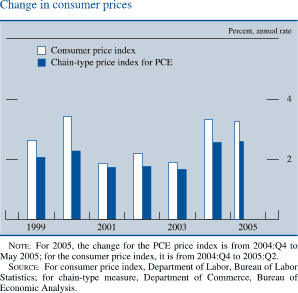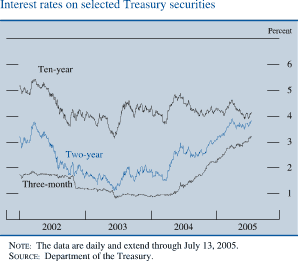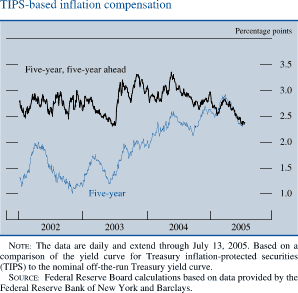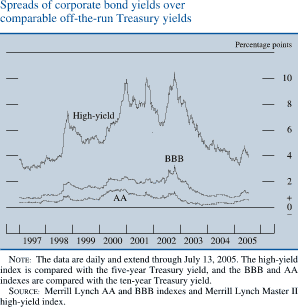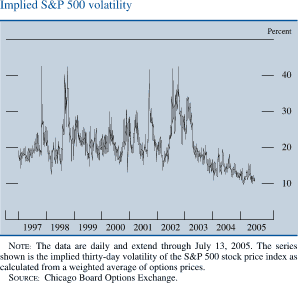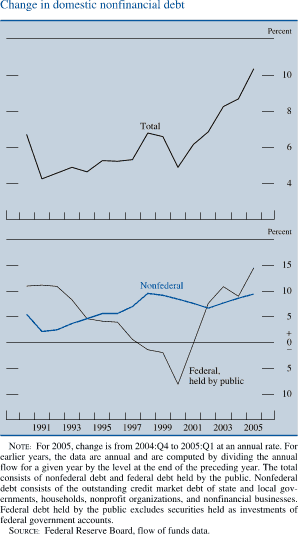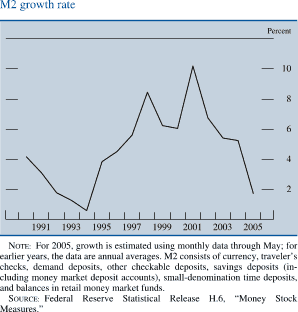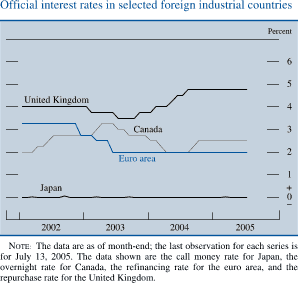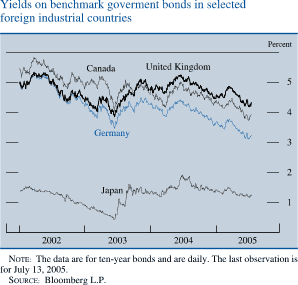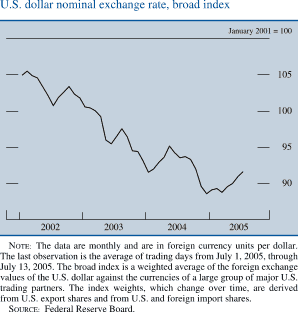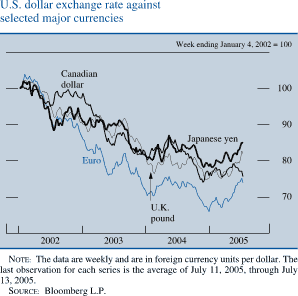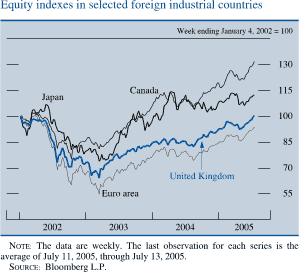
Monetary Policy Report submitted to the Congress on July 20, 2005, pursuant to section 2B of the Federal Reserve Act
Section 2
ECONOMIC AND FINANCIAL DEVELOPMENTS IN 2005
The economic expansion entered 2005 on a solid footing and was led by ongoing increases in consumption, residential investment, and business spending on equipment and software. Although the pace of expansion slowed somewhat in the early spring, activity has picked up again more recently. On average, real GDP appears to have increased a little less rapidly over the first half of 2005 than in the second half of 2004, a reflection in part of reduced fiscal stimulus and the drag on economic activity from higher energy prices. Industrial production has also risen more slowly so far this year than in 2004: The increase totaled 3 percent at an annual rate between December 2004 and June 2005, down from 5 percent during the previous six months. Nevertheless, the economic expansion has been sufficient to gradually absorb slack in labor and product markets. Nonfarm payroll employment has continued to increase, and the unemployment rate has moved down further since the beginning of the year, to 5 percent in June. Similarly, the rate of capacity utilization in the manufacturing sector stood at 78.4 percent in June, up from 77.9 percent at the end of 2004 and just a little below its long-term historical average.
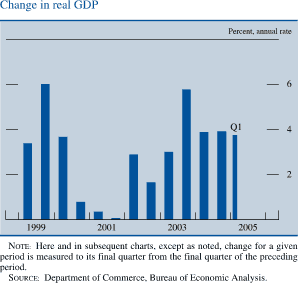
Rising energy prices continued to boost consumer price inflation in the first half of 2005. With consumer energy prices having climbed more than 13 percent at an annual rate so far this year, the price index for personal consumption expenditures (PCE) increased at an annual rate of about 2-1/2 percent between the fourth quarter of 2004 and May 2005, the same pace as in 2004. Meanwhile, the core PCE price index rose at an annual rate of about 2 percent in the first half of 2005, up from 1-1/2 percent in 2004.
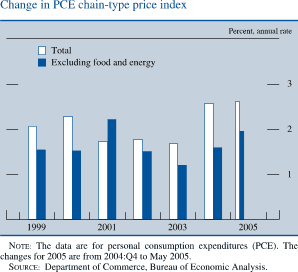
The Household Sector
Consumer Spending
Consumer spending continued to move higher in the first half of this year, though not as rapidly as in the second half of 2004. After increasing at an average annual rate of 4-1/2 percent in the third and fourth quarters of last year, real personal consumption expenditures rose at a 3-1/2 percent rate in the first quarter and appear to have advanced at a roughly similar pace in the second quarter. Household spending this year has been supported by rising employment and household wealth as well as by the low level of interest rates. However, higher costs for consumer energy products have eroded households' purchasing power.
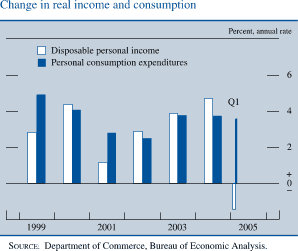
Sales of light motor vehicles, which had been buoyed in the second half of last year by a variety of sales inducements, dropped back in the first quarter after many of the inducements expired. However, sales firmed again in the second quarter to an average annual pace of more than 17 million units, a level similar to that in the fourth quarter of last year. Underlying demand for light motor vehicles has remained relatively strong, though sales likely have also been boosted recently by sizable price discounts.
Excluding motor vehicles, consumer spending posted strong gains in early 2005, flattened out in March, and picked up again in the spring. On a quarterly average basis, the rate of increase in non-auto spending appears to have stepped down in the second quarter, largely because of a deceleration in outlays for consumer goods. Meanwhile, real outlays for services rose at an annual rate of about 3 percent in the first quarter, and the available data point to an increase of about the same magnitude in the second quarter.
If the effect of Microsoft's $32 billion special dividend payment in December 2004 is excluded from the calculation, real disposable personal income (that is, after-tax income adjusted for inflation) rose at an annual rate of about 2 percent between the fourth quarter of 2004 and May 2005, a slower pace than in 2004. Although increases in employment and earnings pushed up wage and salary income over the first half of 2005, the rise in real income was damped to some degree by the energy-driven increase in consumer prices. Higher energy prices also appear to have weighed on consumer confidence for much of this year. Surveys by both the Michigan Survey Research Center (SRC) and the Conference Board indicate that household sentiment edged down through the early spring, though readings from these surveys turned up again more recently.
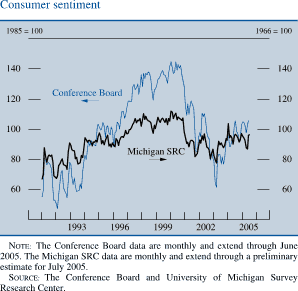
Household wealth appears to have increased a bit faster than nominal disposable income over the first half of this year; the small increase in the wealth-to-income ratio comes on the heels of substantial increases in 2003 and 2004. Although stock prices have changed little, on net, thus far this year, home prices have continued to rise sharply. Because changes in wealth influence consumer spending with a lag, both the earlier and the more-recent increases in household net worth have supported consumption this year. As wealth increased and interest rates remained quite low, the personal saving rate edged down to just 1/2 percent of disposable income in April and May. Over the previous two decades, the personal saving rate averaged close to 5 percent.
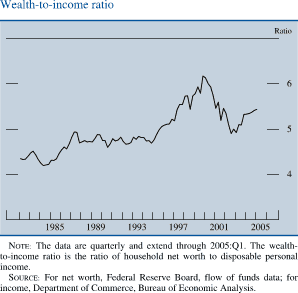

Residential Investment
Activity in the housing market continued at a strong pace in the first half of 2005. Real expenditures on residential structures increased at an annual rate of 11-1/2 percent in the first quarter and appear to have posted another gain in the second quarter. In the single-family sector, starts of new units averaged 1.69 million at an annual rate between January and June--nearly 4 percent above the pace posted over the second half of 2004. Similarly, starts of multifamily units averaged 360,000 over the first six months of 2005, about 3-1/4 percent higher than in the previous six months.
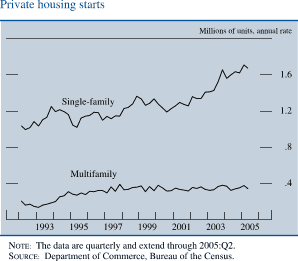
As in 2004, the demand for housing during the first half of 2005 was supported by rising employment and income and by low mortgage rates. Rates on thirty-year fixed-rate mortgages have fluctuated between 5-1/2 percent and 6 percent in recent months and are currently near the low end of that range. In addition, demand reportedly has been boosted by a rise in purchases of second homes--either as vacation units or as investments--and by the greater availability of less-conventional financing instruments. These financing instruments, including interest-only mortgages and adjustable-rate mortgages that allow borrowers a degree of flexibility in the size of their monthly payments, have enabled some households to buy homes that would otherwise have been unaffordable. As a result, both new and existing home sales have remained remarkably robust this year, and both were at or near record levels in May.

The strong demand for housing has continued to push up home prices this year. Although rates of house price appreciation were a little slower in the first quarter of this year than in 2004, the repeat-transactions price index for existing homes (limited to purchase-transactions only), which is published by the Office of Federal Housing Enterprise Oversight and partially adjusts for changes in the quality of homes sold, was nonetheless up 10 percent relative to its year-earlier level. Price appreciation has been especially sharp over the past year in some large metropolitan areas, including Las Vegas, Miami, San Francisco, and New York, but rapid increases in home prices have been observed in other areas as well. In many of these locales, recent price increases have far exceeded the increases in rents and household incomes.
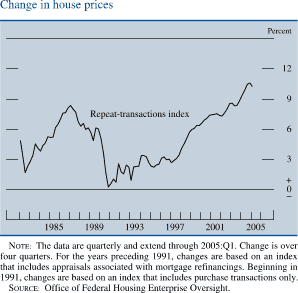
Household Finance
Supported by rising house prices and continued economic expansion, household debt increased at an annual rate of about 9-1/4 percent in the first quarter of 2005. This advance was paced by a rise in mortgage debt of 10-1/2 percent at an annual rate. However, even that rapid rise in mortgage debt represented a slight deceleration from the torrid pace in 2004, a development in line with the small slowdown in the pace of house price appreciation. Despite the increase in mortgage debt, net housing wealth rose. Refinancing activity has remained subdued, as rates on fixed-rate mortgages are a little above levels at which many households would currently find refinancing to be attractive.
Consumer credit expanded at an annual rate of about 4-1/2 percent over the first quarter of the year and was about unchanged in April and May. The growth of consumer credit has continued to be restrained by substitution toward home equity debt as a means to finance household expenditures.
Measures of household credit quality have remained favorable. Delinquency rates on credit card debt and auto loans have continued to decline from already low levels. The pace of bankruptcy filings has run a little higher than at the same time last year; however, that pace has probably been boosted by a rush to file before the new rules in the Bankruptcy Abuse Prevention and Consumer Protection Act of 2005 take effect in October. Reflecting the rapid pace of household debt growth, the ratio of household financial obligations to disposable personal income has edged up from a year earlier, though this ratio remains a bit below the peak level reached in late 2002.
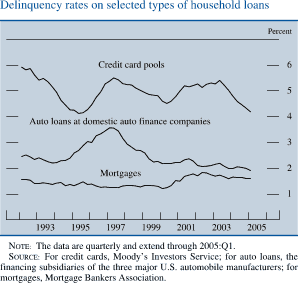
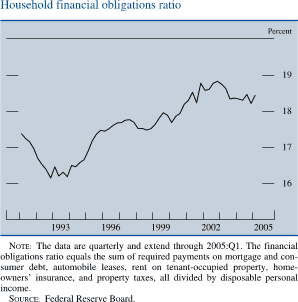
The Business Sector
Fixed Investment
After posting a robust gain in the second half of 2004, real business fixed investment rose at a more moderate pace over the first half of 2005, as the rate of increase in expenditures on equipment and software (E&S) dropped back and outlays for nonresidential structures remained lackluster. Nonetheless, economic and financial conditions appear to be supportive of capital spending: Sales and corporate profits have continued to increase, businesses have ample liquid assets at their disposal, and financial market participants appear willing to finance new investment projects at favorable terms.
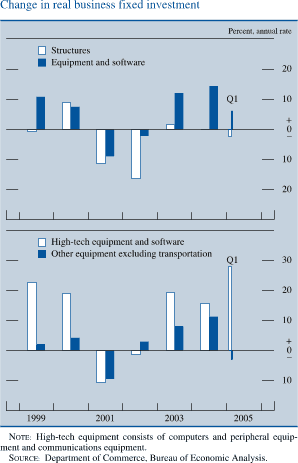
Real E&S spending rose at an annual rate of 6 percent in the first quarter after having advanced at an 18 percent pace in the second half of 2004. Led by large increases in purchases of computers and communications equipment, spending on high-tech equipment posted a sizable gain in the first quarter. In contrast, outlays for transportation equipment dropped back early in the year because of a small decline in business expenditures on motor vehicles and a sharp drop in aircraft purchases after a surge in the fourth quarter of 2004. Investment in equipment other than high-tech and transportation goods, a category that accounts for about 40 percent of E&S in nominal terms, also edged down in the first quarter after registering a sizable gain in the second half of last year. The types of equipment in this category of investment tend to be sensitive to trends in business sales, but the timing of business spending may have been influenced by the provisions of the partial-expensing tax incentive, which encouraged capital spending to be pulled forward in advance of the incentive's expiration at the end of 2004.
More-recent indicators of E&S spending point to another moderate rise in investment in the second quarter. In particular, outlays for transportation equipment appear to have turned up, on net, as a step-up in purchases of aircraft more than offset a further decline in business spending on motor vehicles. At the same time, the evidence on high-tech spending has been mixed: Real spending on computers appears to have registered another large gain in the second quarter, while the rate of increase in outlays for communications equipment apparently fell back. Indicators of spending on equipment other than transportation and high tech have looked more favorable recently, as shipments and imports for this broad category increased noticeably, on balance, in April and May. In addition, unfilled orders for such equipment remain at high levels.
Real nonresidential construction continued at a low level in the first half of this year, but fundamentals are starting to show signs of improvement. The construction of office buildings and industrial facilities has been restrained for some time by elevated vacancy rates, weak demand, and higher costs for construction materials. However, vacancy rates in these sectors have recently turned down, and construction outlays for these types of buildings appear to have edged higher, on net, so far this year. Commercial building--which includes retail outlets and warehouses--also appears to have increased this year, in part because of strong growth in the construction of large retail stores. Meanwhile, investment in the drilling and mining sector has trended up, on balance, over the past year, as higher prices for natural gas boosted the demand for new drilling rigs.
Inventory Investment
As in 2004, businesses accumulated inventories at an appreciable pace early this year. Outside the motor vehicle industry, nonfarm inventories increased at an annual rate of $66 billion in real terms in the first quarter of 2005. The rapid rate of inventory accumulation late last year and early in 2005 appears primarily to have been the result of efforts by firms to replenish stocks that had been depleted by the strong pace of sales in 2003 and 2004; apart from firms in a limited number of sectors, such as steel and paper, most businesses do not appear to be holding excess stocks, even taking into account the downward trend in inventory-sales ratios that has resulted from the improvement in supply-chain management capabilities. The rebuilding of inventories in most industries appears to have been largely completed, and the available data for April and May point to a noticeable step-down in the pace of stockbuilding. Indeed, in recent surveys, businesses have been reporting that they and their customers are increasingly comfortable with current levels of stocks, whereas in 2004 and early 2005, many were still characterizing inventory positions as too lean.
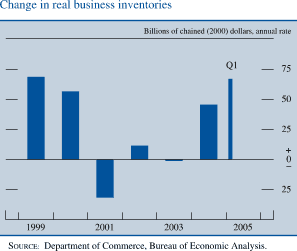
One important exception to this characterization is the motor vehicle industry, for which dealer stocks--especially of light trucks--were high by historical standards in recent months. In response, several major motor vehicle manufacturers reduced production in the second quarter, and, more recently, some have introduced price discounts on many 2005 models. These efforts appear to have helped, in that inventories of light vehicles at the end of June fell to sixty-five days of supply, a level more in line with historical norms.
Corporate Profits and Business Finance
Corporate profits have continued to rise so far this year, though at a slower pace than in 2003 and 2004. Earnings per share for S&P 500 firms in the first quarter of 2005 were up about 13 percent since the same time last year, a pace in line with the profit figures reported in the national income and product accounts (NIPA). The ratio of before-tax profits of nonfinancial corporations to that sector's gross value added was about flat in the first quarter after having moved up in 2003 and 2004. In the first half of this year, the petroleum and gas industries benefited from higher oil prices, but corporate earnings in the automobile sector declined sharply.
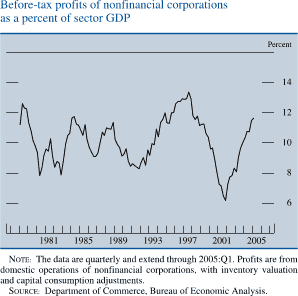
Given continued strong corporate profits and the accompanying strength in cash flow, nonfinancial firms' demand for external financing to fund capital expenditures has remained somewhat subdued. Net equity issuance has stayed negative so far this year, and share retirements have been boosted by considerable stock buybacks and cash-financed merger and acquisition activity. Gross corporate bond issuance has been limited, and the proceeds have been used mainly to pay down existing debt. Short-term debt financing, however, continued to pick up in the first half of 2005. Both commercial and industrial loans and commercial paper expanded at a brisk pace that was likely in part the result of firms' need to fund the rapid rate of inventory accumulation earlier in the year. The Federal Reserve's Senior Loan Officer Opinion Survey on Bank Lending Practices conducted in April 2005 indicated that demand for business loans had strengthened over the previous three months and that substantial fractions of banks had eased standards and terms on these loans. In response to special questions regarding longer-term changes in lending practices, most banks reported that standards on business loans were somewhat tighter, but that terms were somewhat easier, than they had been in 1996 and 1997.
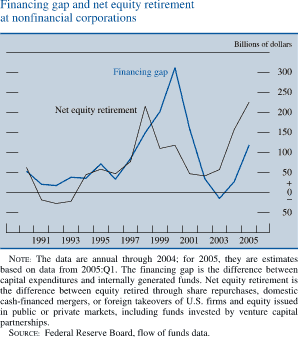

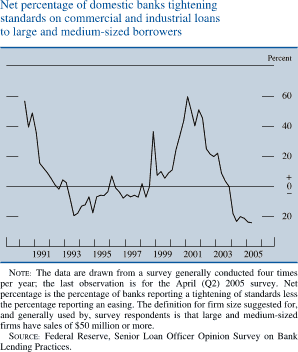
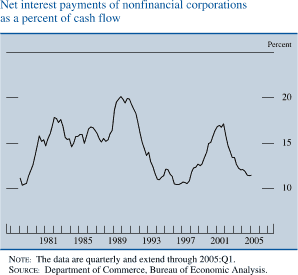
Indicators of credit quality in the nonfinancial business sector have stayed generally very strong amid continued growth of profits and corporate balance sheets that remain flush with liquid assets. Both the default rate on outstanding corporate bonds and the delinquency rate on business loans stand at the low end of their historical ranges. However, the automobile sector has been an exception to the pattern of solid corporate credit quality. All three major credit rating agencies downgraded the debt of both Ford and General Motors this year in response to disappointing earnings news. General Motors' debt now has a below-investment-grade rating from both Standard & Poor's and Fitch, though it is still rated as investment-grade by Moody's. Ford retains an investment-grade rating with all the rating agencies except Standard & Poor's.
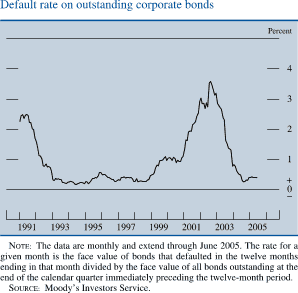
Expansion of commercial-mortgage debt continued apace in the first half of the year and was accompanied by record issuance of commercial-mortgage-backed securities. Likely because of that heavy issuance, spreads of yields on commercial-mortgage-backed securities over those on comparable-maturity Treasuries have turned up recently, but these spreads remain relatively low. The credit quality of commercial-mortgage debt remains quite strong, as delinquency rates on holdings of commercial mortgages at banks and insurance companies and on loans that back mortgage securities have been declining from already low levels.
The Government Sector
Federal Government
The deficit in the federal unified budget narrowed over the past year. Over the twelve months ending in June, the unified budget recorded a deficit of $336 billion, $99 billion less than during the comparable period last year. Both revenues and outlays rose faster than did nominal GDP over this period, but the rise in receipts was especially strong. Even at its lower level, the deficit was still equal to about 2-3/4 percent of nominal GDP.
Nominal federal receipts during the twelve months ending in June were 14 percent higher than during the same period a year earlier and reached 17 percent of nominal GDP. Revenues were boosted by a large increase in corporate receipts that was driven by the strength of corporate profits. In addition, individual income and payroll taxes rose nearly 12 percent, twice as fast as the growth of household income. However, some of this rise was due to the features of the Jobs and Growth Tax Relief Reconciliation Act of 2003 that altered the timing of tax payments in a way that temporarily reduced the level of tax collections last year.
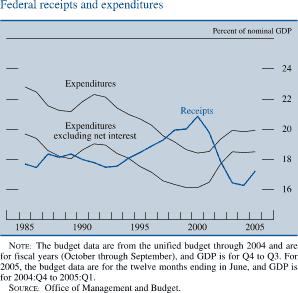
Nominal federal outlays during the twelve months ending in June were 7 percent higher than during the same period a year ago and stood at 20 percent of nominal GDP. Spending for national defense continued to trend up at a rapid clip, and outlays for Medicare also posted a sizable increase. In addition, federal net interest payments, boosted both by higher interest rates and by the higher level of federal debt, rose more than 13 percent over this period. Real federal expenditures for consumption and investment--the part of government spending that is a component of real GDP--increased at an annual rate of just 1/2 percent in the first calendar quarter of 2005 after having risen 4 percent in 2004. Although defense spending changed little in real terms in the first quarter, it has risen considerably in recent years and is likely to increase further in coming quarters. Nondefense spending in the first quarter edged up in line with its recent trend, and enacted legislation is consistent with its continuing to rise at a subdued pace.

The deficit in the federal budget has depressed national saving in the past few years. The narrowing of the deficit of late has lessened this reduction in national saving from a little more than 3 percent of nominal GDP in 2003 and 2004 to roughly 2 percent in the first quarter of 2005. Even so, as business and personal saving rates changed little, on average, over the past year, net national saving rose to just 3-1/4 percent of nominal GDP in the first quarter, well below the long-term historical average of about 7 percent and below recent levels of net domestic investment. If not reversed, such a low level of net national saving will necessitate either slower capital formation or continued heavy borrowing from abroad. The pressures on national saving will intensify greatly with the retirement of the baby-boom generation and the associated increases in Social Security and Medicare benefit payments.
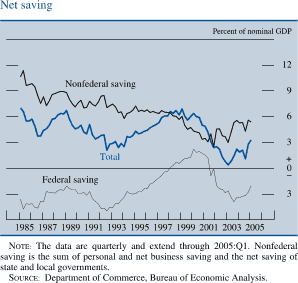
Federal Borrowing
Because of the need to finance the sizable federal budget deficit, federal debt held by the public expanded at a seasonally adjusted annual rate of 13-3/4 percent in the first quarter of the year. The ratio of this debt to nominal GDP increased to more than 37 percent for the first time since 2000. The average maturity of outstanding marketable Treasury debt has been declining for several years and reached fifty-three months at the end of the first quarter of 2005, down from about seventy months in 2000. However, in the May mid-quarter refunding statement, the Treasury announced that it was considering reintroducing regular issuance of a thirty-year nominal bond in February 2006, a move that would presumably slow or arrest this downtrend.
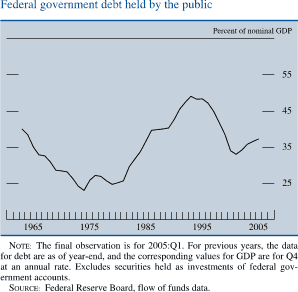
Indicators of demand for Treasury securities by foreign investors have been mixed so far this year; demand by foreign official institutions seems to have moderated, but demand by foreign private investors appears to have remained robust. Indirect bidders at Treasury auctions--which include foreign official institutions that place bids through the Federal Reserve Bank of New York--have been awarded an average of 33 percent of coupon securities issued at auctions held so far this year, down from 42 percent in 2004. Treasury securities held in custody at the Federal Reserve Bank of New York on behalf of foreign official institutions have grown only about $25 billion so far this year after an increase of more than $200 billion in 2004. Data from the Treasury International Capital System also suggest an ebbing of demand for Treasury securities from foreign official investors during the first five months of the year. These data, however, indicate that foreign private investors have continued to accumulate Treasury securities at a rapid pace.
State and Local Governments
The fiscal positions of states and localities have improved this year. Ongoing gains in income and consumer spending, along with sharp increases in property values, have continued to boost tax receipts. Although many jurisdictions have increased their spending moderately, some are also using the additional revenues to rebuild reserve funds. On a NIPA basis, net saving by state and local governments equaled $34 billion at an annual rate in the first quarter (roughly 1/4 percent of nominal GDP), double the 2004 average. In addition, virtually all states registered surpluses in their general fund budgets in fiscal year 2005, which ended on June 30 for all but four states. Nevertheless, lingering fiscal concerns are still evident in some jurisdictions; these concerns are related primarily to rising Medicaid costs, the termination of temporary federal grants that were appropriated in fiscal year 2004, and pressures to restore funding to programs--such as elementary and secondary education--that were cut back earlier in the decade.
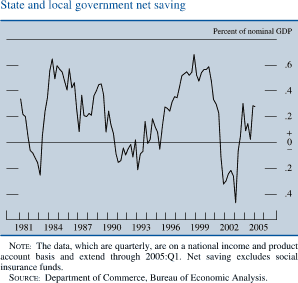
Real consumption and investment spending by state and local governments edged down in the first quarter of 2005 after having changed little in 2004. Real outlays for consumption items increased at an annual rate of less than 1/2 percent, a reflection of some slowing in the pace of hiring. Nominal spending on investment rose at a moderate rate in the first quarter, but because construction costs escalated, investment spending declined a little in real terms.
State and Local Government Borrowing
State and local government debt held by the public expanded at a rapid pace in the first quarter of the year, rising at a seasonally adjusted annual rate of 16-1/4 percent, up from 5-1/2 percent in the fourth quarter of last year. However, much of this borrowing was for the advance refunding of existing debt, as state and local governments continued to take advantage of low long-term interest rates. A significant portion of the proceeds of these advance refundings were invested in U.S. Treasury instruments tailored to meet the cash management needs of municipal governments. In addition, financing of transportation- and education-related projects boosted issuance of long-term municipal bonds for new capital.
The credit quality of municipal borrowers improved last year, and this trend has generally continued so far in 2005, as upgrades of municipal bonds by Standard & Poor's continued to outpace downgrades.
The External Sector
The U.S. current account deficit expanded in the first quarter of 2005 to $780 billion at an annual rate, or about 6.4 percent of nominal GDP. The deficit in trade in goods continued to widen, increasing $17 billion from the previous quarter. The deficit on net unilateral transfers also widened in the first quarter, largely because of an increase in government grants. In contrast, the surplus on trade in services rose $7 billion, and the surplus on net investment income rose $2 billion.
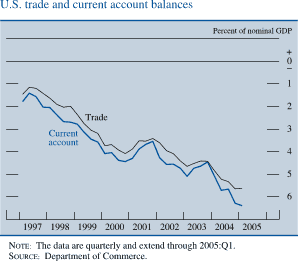
International Trade
Real exports of goods and services accelerated in the first quarter of 2005 to an annual rate of about 9 percent, roughly twice as fast as the rate in the second half of last year. The dollar's decline in recent years has raised the competitiveness of U.S. relative prices and has continued to provide a mounting boost to exports. Support from foreign economic activity, though still substantial, moderated after the first half of 2004 as growth abroad slowed. Increases in exports of U.S. goods were widespread across major U.S. trading partners, with the exception of Japan, and were concentrated in capital goods and consumer goods. Real exports of services rose at an annual rate of about 13-1/4 percent.

Real imports of goods and services rose at an annual rate of about 9-1/2 percent in the first quarter, a pace similar to the average in 2004. The growth of real oil imports ebbed after surging late last year. Increases in imports of non-oil goods were widespread across categories. The expiration of the Multifibre Arrangement and the resulting elimination of quotas shifted the source of some U.S. textile and apparel imports among U.S. trading partners, but these events appear to have had a limited effect on the overall level of imports of these goods. Real imports of services reversed their fourth-quarter decline, posting a gain of 7 percent at an annual rate, as some travel-related expenditures and also royalties and license fees recovered from a very weak fourth quarter.
Boosted by substantial increases in the prices of primary commodities and industrial supplies, prices of total exports rose at an annual rate of 4-1/4 percent in the first quarter. Prices of U.S. agricultural exports rebounded in the first quarter after good harvests in the second half of 2004 had caused prices to fall sharply. The available data for the second quarter point to continued increases in export prices.
Prices of imported non-oil goods rose at an annual rate of 3-3/4 percent in the first quarter, almost 1-1/2 percentage points faster than in the second half of 2004. Prices of material-intensive items, such as industrial supplies and foods, steadily increased in the last quarter of 2004 and in the first quarter of 2005. In part, this rise reflected higher prices for nonfuel primary commodities, as strength in global demand for many commodities outstripped a slow expansion of supply. Prices for finished goods, such as consumer goods and many kinds of capital goods, also turned noticeably higher. Available data for the second quarter show that the increases in prices of both material-intensive and finished goods have slowed.
The spot price of West Texas intermediate (WTI) crude oil began 2005 near $43 per barrel, but it climbed above $50 per barrel in late February and breached $60 per barrel in late June. The increase in the spot price of WTI largely reflects several global factors: continued strong demand for oil, limited spare production capacity, and concerns about the reliability of supply from some foreign sources. In contrast to the market outlook during last October's peak in oil prices, futures contracts indicate that market participants now expect oil prices to remain near their current high levels, a view consistent with the belief that demand will remain strong and production will have difficulty keeping pace. The price of the far-dated NYMEX oil futures contract (currently for delivery in December 2011) rose from about $38 per barrel as of last October to about $56 per barrel in late June.
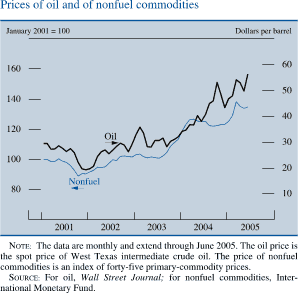

OPEC spare production capacity appears to be near historical lows, with only Saudi Arabia able to increase production substantially. Many other OPEC producers are either pumping close to capacity or encountering production problems. Venezuela and Indonesia cannot meet their production quotas, and Iraqi production this year has averaged less than in 2004. In addition, several governments have moved to increase their control of the energy industry as oil prices have risen. Russian oil production, which had provided most of the growth in non-OPEC supply over the previous five years, has stagnated since last September amid the partial nationalization of Yukos, formerly Russia's largest oil company. Venezuela has also increased the taxes and royalty payments of foreign oil firms.
The Financial Account
Foreign official inflows, which accounted for more than half of all net financial inflows to the United States in 2004, slowed significantly in the first quarter but showed signs of renewed strength in April and May. In contrast, private inflows moderated in April and May after having increased substantially in the preceding six months. As has been the case for several years, the U.S. current account has been financed primarily by foreign purchases of U.S. debt securities. U.S. residents' purchases of foreign securities increased after a temporary lull in the fourth quarter and have been more heavily weighted toward purchases of equities.
Net direct investment outflows in the first quarter were well below their levels in the fourth quarter; direct investment into the United States was roughly unchanged, but U.S. direct investment abroad fell back after a surge in new equity late last year. There is little evidence to date that U.S. companies have repatriated earnings from their foreign subsidiaries using the temporarily reduced tax rate available under the American Jobs Creation Act of 2004. However, there are indications that these remittances may pick up in the second half of this year.
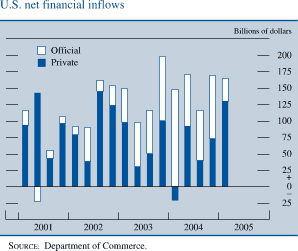
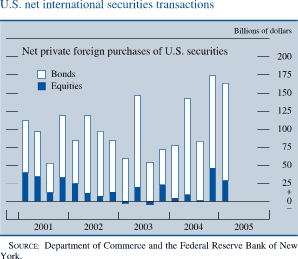
The Labor Market
Employment and Unemployment
Labor markets have continued to improve this year, albeit at an uneven pace from month to month. On average, nonfarm payroll employment expanded roughly 180,000 per month over the first half of 2005, about the same pace as in the fourth quarter of 2004. At the same time, the civilian unemployment rate, which had declined from 5-3/4 percent to just below 5-1/2 percent over 2004, continued to move down. The jobless rate stood at 5 percent in June, the lowest level since September 2001.
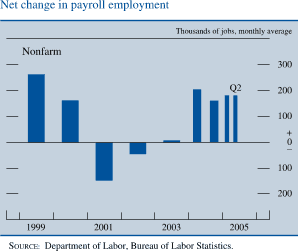
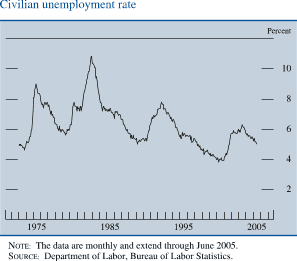
The increases in payrolls over the first half of 2005 were relatively widespread across industries. Particularly sizable gains were registered at providers of health-care services and leisure and hospitality services and at establishments that provide business services, such as professional and technical assistance and administrative and support services (a category that includes temporary help). In addition, construction employment continued to climb at a steady pace, a reflection of the buoyant residential housing market and increased spending on infrastructure by state and local governments. In contrast, manufacturing employment continued to trend down, as cutbacks in industries that produce wood products, furniture, and a variety of nondurable goods more than offset hiring at producers of fabricated metals and machinery. Employment in retail trade has advanced at a moderate pace this year. Increases in employment at state and local governments slowed somewhat in the first half of this year from the pace in the second half of last year, and federal civilian employment changed little.
The gradual rise in job opportunities appears to be attracting some potential workers back into the labor market. The labor force participation rate, which had declined noticeably between 2000 and 2004, edged up over the first half of 2005. Nevertheless, the participation rate in June, at 66 percent, remained well below the high of 67-1/4 percent reached in early 2000. To some extent, both the high level of the participation rate in 2000 and the more recent decline are likely related to cyclical developments in the economy: The tight labor markets of the late 1990s, perhaps coupled with the introduction of work requirements for many welfare recipients, undoubtedly drew additional people into the labor force at that time, while the subsequent recession and slow recovery in the labor market have discouraged many job seekers in recent years. However, the downtrend in the aggregate participation rate also appears to be associated with structural developments that seem likely to limit future increases. For example, the large baby-boom cohorts are now entering ages at which labor force participation rates typically drop off sharply. And, in contrast to patterns observed in previous decades, participation rates for women between 25 and 54 years of age no longer appear to be trending up.
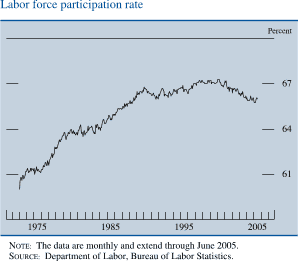
Productivity and Labor Costs
Gains in labor productivity have slowed, on balance, in recent quarters. According to currently published data, output per hour in the nonfarm business sector rose 2-1/2 percent over the year ending in the first quarter of 2005, down from the 5-1/2 percent pace registered in the comparable period a year earlier. A deceleration in productivity is not unusual as an economic expansion matures and as businesses--which become increasingly confident about future prospects for sales--step up their pace of hiring. In addition, the recent slowdown in productivity growth was from the unusually rapid average rate that prevailed between 2002 and early 2004. That elevated rate likely reflected both an atypical reluctance to hire--as employers reacted to a succession of economic and geopolitical shocks--and newfound efficiencies brought about by the better use of high-tech capital purchased by businesses in earlier years and by organizational changes implemented to maintain profitability when the economy was relatively weak. As the impetus from these influences has waned, productivity growth has fallen back.

Measures of labor compensation for recent quarters suggest that the remaining slack in labor markets continued to restrain increases in base wage rates but that large increases in some of the more flexible components of worker pay and for some types of employer-provided benefits added to labor costs. In particular, compensation per hour in the nonfarm business sector, which is based on the data from the national income and product accounts, rose 7 percent over the four quarters ending in the first quarter of this year, having registered a particularly large bulge in the final quarter of 2004. Much of this sharp rise may be the result of the exercise of a large number of stock options late last year, a development perhaps induced by an increase in equity prices that boosted the number of options that were "in the money" and by a proposed change in accounting regulations that led some companies to accelerate the vesting of options that had been previously granted. In addition, the strong performance of profits in 2004 may have been associated with sizable nonproduction bonus payments at the end of last year.
A more modest rate of increase in hourly compensation is indicated by the employment cost index (ECI), which is based on a quarterly survey of private nonfarm establishments conducted by the Bureau of Labor Statistics and which excludes income received from the exercise of stock options. In particular, the ECI measure of hourly compensation rose 3-1/2 percent over the twelve months ending in March 2005, about 1/2 percentage point less than the increases over the preceding two years. The wages and salaries component of the ECI was up just 2-1/2 percent over the twelve months ending in March, a pace similar to that in the preceding year, while employer costs for benefits increased 5-3/4 percent, a bit below the pace of the previous year but a sizable gain nonetheless. Part of the outsized rise in benefit costs stemmed from the need by many companies to rebuild their defined-benefit pension assets to make up for earlier losses in those plans. In addition, health insurance costs have continued to rise more rapidly than wages, although the 7-1/2 percent increase in these costs over the year ending in March of this year was down from the double-digit rates of growth in 2002 and 2003.

The acceleration in the nonfarm business measure of hourly compensation, coupled with the deceleration in productivity, has contributed to a noticeable pickup in unit labor costs in recent quarters. In particular, unit labor costs rose 4-1/4 percent over the four quarters ending in the first quarter of 2005 after having declined 1 percent over the preceding four quarters. However, to the extent that the acceleration in compensation was the result of a temporary bulge in stock option exercises in late 2004, unit labor costs should moderate significantly this year. Moreover, the implications of such a spike in unit labor costs for price inflation are probably minimal, at least as judged by previous spikes of this nature. For example, the sharp rise in unit labor costs in 2000 had little or no subsequent effect on price inflation.

Prices
Higher energy prices continued to show through to overall consumer price inflation this year. The chain-type price index for personal consumption expenditures rose at an annual rate of about 2-1/2 percent between the fourth quarter of 2004 and May 2005, a rate of increase similar to that over the four quarters of 2004. Within that total, core PCE prices accelerated over that period to an annual rate of about 2 percent, from 1-1/2 percent in 2004. However, data for the consumer price index (CPI), which are available through June, suggest that core inflation has moderated in recent months; the core CPI rose at an annual rate of 1-1/4 percent in the three months ending in June after having increased at a 3-1/4 percent pace over the first three months of this year.
